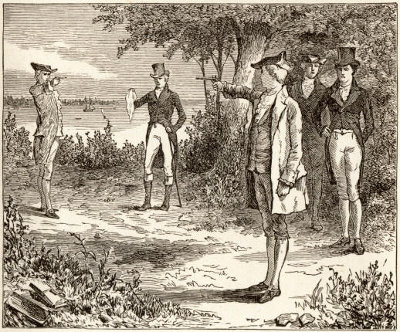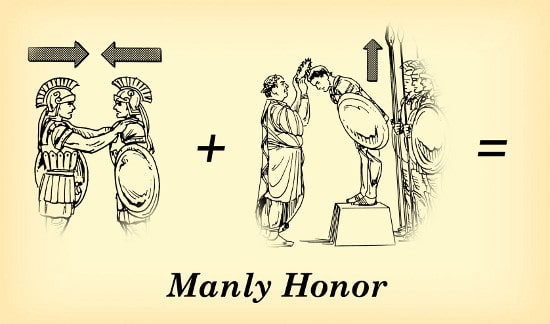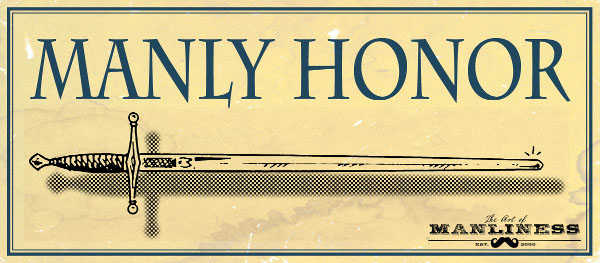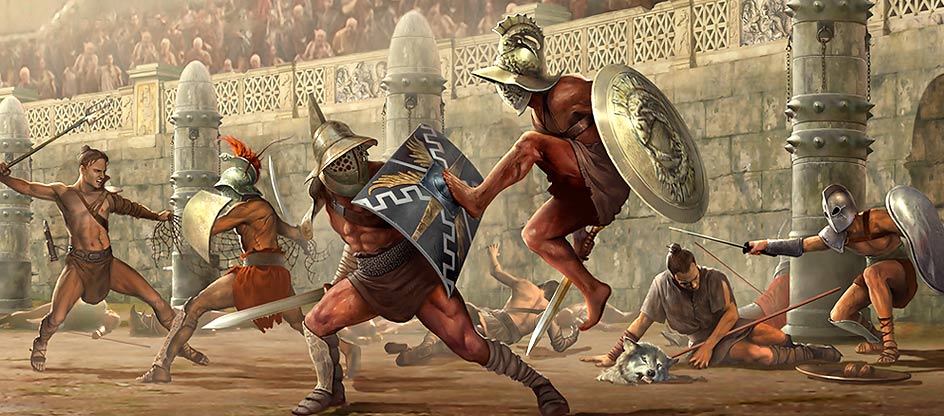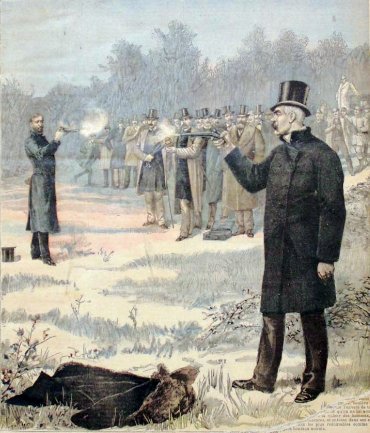
Editor’s note: This post was co-written by Chris Hutcheson and Brett McKay.
In our modern age, solving a problem by asking a dude to step outside is generally considered an immature, low class thing to do.
But for many centuries, challenging another man to a duel was not only considered a pinnacle of honor, but was a practice reserved for the upper-classes, those deemed by society to be true gentlemen.
“A man may shoot the man who invades his character, as he may shoot him who attempts to break into his house.” -Samuel Johnson
While dueling may seem barbaric to modern men, it was a ritual that made sense in a society in which the preservation of male honor was absolutely paramount. A man’s honor was the most central aspect of his identity, and thus its reputation had to be kept untarnished by any means necessary. Duels, which were sometimes attended by hundreds of people, were a way for men to publicly prove their courage and manliness. In such a society, the courts could offer a gentleman no real justice; the matter had to be resolved with the shedding of blood.
How did this violent way to prove one’s manhood evolve? Let’s take a look at the history of the affair of honor and the code duello which governed it.
Origins in Single Combat
In the ancient tradition of single combat, each side would send out their “champion” as the representative of their respective armies, and the two men would fight to the death. This contest would sometimes settle the matter, or would serve only as a prelude to the ensuing battle, a sign to which side the gods favored. Prominent single combat battles have made their way into the records of history and legend, such as the battle between David and Goliath in the Valley of Elah and Achilles’ clashes with both Ajax and Hector in Homer’s Iliad. As warfare evolved, single combat became increasingly less prevalent, but the ethos of the contest would lend inspiration to the gentlemen’s duel.
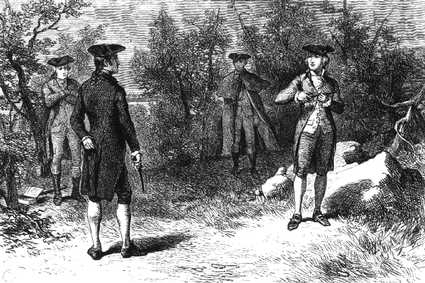
Dueling in Europe
“A coward, a man incapable either of defending or of revenging himself, wants one of the most essential parts of the character of a man.” Adam Smith, The Wealth of Nations
Dueling began in ancient Europe as “trial by combat,” a form of “justice” in which two disputants battled it out; whoever lost was assumed to be the guilty party. In the Middle Ages, these contests left the judicial sphere and became spectator sports with chivalrous knights squaring off in tournaments for bragging rights and honor.
But dueling really became mainstream when two monarchs got into the act. When the treaty between France and Spain broke down in 1526, Frances I challenged Charles V to a duel. After a lot of back and forth arguing about the arrangements of the duel, their determination to go toe to toe dissipated. But the kings did succeed in making dueling all the rage across Europe. It was especially popular in France; 10,000 Frenchmen are thought to have died during a ten year period under Henry IV. The king issued an edict against the practice, and asked the nobles to submit their grievances to a tribunal of honor for redress instead. But dueling still continued, with 4,000 nobles losing their lives to the practice during the reign of Louis XIV.
Dueling in America
“Certainly dueling is bad, and has been put down, but not quite so bad as its substitute — revolvers, bowie knives, blackguarding, and street assassinations under the pretext of self-defense.” -Colonel Benton
Dueling came to American shores right along with her first settlers. The first American duel took place in 1621 at Plymouth Rock.
Dueling enjoyed far more importance and prevalence in the South than the North. Antebellum society placed the highest premium on class and honor, and the duel was a way for gentlemen to prove both.
The majority of Southern duels were fought by lawyers and politicians. The law profession was (as it is now) completely saturated, and the competition for positions and cases was acute. In this dog-eat-dog society, jostling for position and maintaining an honorable reputation meant everything. Every perceived slight or insult had to be answered swiftly and strongly to save face and one’s position on the ladder to respect and success.
And while we tend to paint modern politics as uncivil and romanticize the past, politicians of the day slung bullets in addition to mud. Legislators, judges, and governors settled their differences with the duel, and candidates for office debated their issues on the “field of honor.” Political showmanship of the day involved timing a duel for right before an election and splashing the results in the papers.
Dueling and Violence
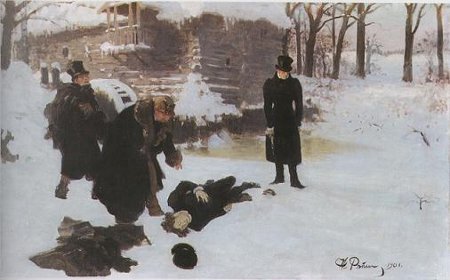
“The views of the Earl are those of a Christian, but unless some mode is adopted to frown down by society the slanderer, who is worse than a murderer, all attempts to put down dueling will be in vain.” -Andrew Jackson
Despite putting on a courageous front, no gentleman relished having to fight a duel and risk both killing and being killed (well, perhaps with the exception of Andrew “I fought at least 14 duels” Jackson). Thus duels were often not intended to be fights to the death, but to first blood. A duel fought with swords might end after one man simply scratched the arm of the other. In pistol duels, it was often the case that a single volley was fired, and assuming both men had survived unscathed, satisfaction was deemed to be achieved through their mutual willingness to risk death. Men sometimes aimed for their opponent’s leg or even deliberately missed, desiring only to satisfy the demands of honor. Only about 20% of duels ended in a fatality.
Duels founded on greater insults to a man’s honor, however, were often designated to go well beyond first blood. Some were carried out under the understanding that satisfaction was not gained until one man was incapacitated, while the gravest insults required a mortal blow.
To us, duels seem like a pointlessly barbaric way to settle disputes; going into a duel the odds were nearly 100% that one man or both would be wounded or killed. And, adding insult to injury, it could very well be the innocent party who was slain.
Even at the time, there were many critics that argued that dueling was unnecessarily violent and contrary to morality, religion, common sense, and indeed, antithetical to the very concept of honor itself. But there were also those who argued that dueling actually prevented violence.
The idea was that single combat warriors averted endless bloody feuds between groups and families ala the Hatfields and McCoys. The duels nipped these potential feuds in the bud as insults were given immediate redress, with satisfaction given to both parties.
The practice was also thought to increase civility throughout society. To avoid being challenged to the duel, gentlemen were careful not to insult or slight others. The courtly, formal manners this time period is famous for-the stately dress, the bowing, toasting, and flowery language-were designed to convey honorable intentions and avoid giving offense. Jealousies and resentments had to be repressed and covered with politeness.
In the 1836 manual, The Art of Duelling, the author summarizes the pro-dueling perspective of the time with comments that seem remarkable to the modern ear:
“The practice is severely censured by all religious and thinking people; yet it has very justly been remarked, that ‘the great gentleness and complacency of modern manners, and those respectful attentions of one man to another, that at present render the social discourses of life far more agreeable and decent, than among the most civilized nations of antiquity; must be ascribed, in some degree to this absurd custom.’ It is certainly both awful and distressing to see a young person cut off suddenly in a duel, particularly if he be the father of a family; but the loss of a few lives is a mere trifle, when compared with the benefits resulting to Society at large.
I should consider it very unwise in the members of government, to adopt any measures that would enforce the prohibition of duelling…the man who falls in a duel, and the individual who is killed by the overturn of a stage-coach, are both unfortunate victims to a practice from which we derive great advantage. It would be absurd to prohibit stage-travelling-because, occasionally, a few lives are lost by an overturn.”
Dueling Necessities
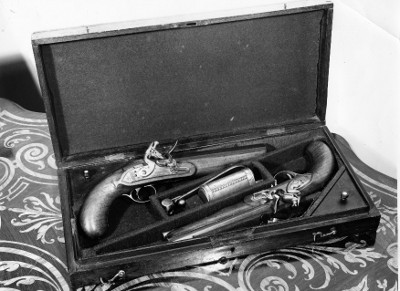
The components of the gentleman’s duel were often quite varied. The challenged party was usually given the choice of weapons, and the possibilities were endless. Duels have been fought with everything from sabers to billiard balls. A duel was once even fought over the skies of Paris, with the participants utilizing blunderbusses in an attempt to rupture each other’s hot air balloons. One succeeded, sending the opposing man and his comrade plummeting to their death, while the winner floated triumphantly away.
Swords were the weapon of choice until the 18th century, when the transition to pistols made dueling more democratic (fencing took skill-a man might challenge another to a duel, spend a year learning swordsmanship, and then return to fight the duel. But nearly anyone could pull a trigger). As the practice of using guns grew in prominence, arms makers began to create sets of pistols specifically built for dueling. The idea behind this practice was simple. If two men were going to engage in a duel, their “equipment” needed to be as similar as possible so as not to give one man an unfair advantage over the other. Thus, by the latter 18th century, sets of dueling pistols were being produced by fine arms makers throughout Europe. Dueling pistols were often smooth bored pistols, and usually fired quite large rounds. Calibers of .45, .50, or even .65 (caliber = inches of diameter) were in common usage. The pistols were made to exact specifications and were tested to ensure that they were as equal in performance and appearance as possible. A man’s dueling pistols were a prized possession, an heirloom passed down from father to son.
Code Duello: The Dueling Code
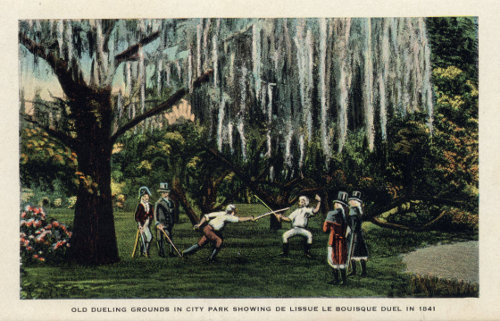
“A duel was indeed considered a necessary part of a young man’s education…When men had a glowing ambition to excel in all manner of feats and exercises they naturally conceived that manslaughter, in an honest way (that is, not knowing which would be slaughtered), was the most chivalrous and gentlemanly of all their accomplishments. No young fellow could finish his education till he had exchanged shots with some of his acquaintances. The first two qualifications always asked as to a young man’s respectability and qualifications, particularly when he proposed for a lady wife, were ‘What family is he of? And ‘Did he ever blaze?” -19th century Irish duelist
Dueling code evolved over the centuries as weapons and notions of honor changed. Proper dueling protocol in the 17th and 18th centuries was recorded in such works as The Dueling Handbook by Joseph Hamilton and The Code of Honor by John Lyde Wilson. While the dueling code varied by time period and country, many aspects of the code were similar.
Despite our romanticized notion of duels as being fought only over the most grievous of disputes, duels could often arise from matters most trivial-telling another man he smelled like a goat or spilling ink on a chap’s new vest. But they were not spontaneous affairs in which an insult was given and the parties marched immediately outside to do battle (in fact, striking another gentleman made you a social pariah). A duel had to be conducted calmly and coolly to be dignified, and the preliminaries could take weeks or months; a letter requesting an apology would be sent, more letters would be exchanged, and if peaceful resolution could not be reached, plans for the duel would commence.
The first rule of dueling was that a challenge to duel between two gentleman could not generally be refused without the loss of face and honor. If a gentleman invited a man to duel and he refused, he might place a notice in the paper denouncing the man as a poltroon for refusing to give satisfaction in the dispute.
But one could honorably refuse a duel if challenged by a man he did not consider a true gentleman. This rejection was the ultimate insult to the challenger.
The most common characteristic of a duel between gentlemen was the presence of a “second” for both parties. The seconds were gentlemen chosen by the principal participants whose job it was to ensure that the duel was carried out under honorable conditions, on a proper field of honor and with equally deadly weapons. More importantly, it was the seconds (usually good friends of the participating parties) who sought a peaceful resolution to the matter at hand in hopes of preventing bloodshed.
Once the challenge to duel was given, several issues had to be settled before the matter could be resolved. The challenger would first allow his foe the choice of weapons and conditions of the combat, and a time would be set for the event. Seconds were responsible for locating a proper dueling ground, usually a remote area away from witnesses and law enforcement, since dueling remained technically illegal in most states, though rarely prosecuted. Duels were sometimes even fought on sandbars in rivers where the legal jurisdiction of the time was hazy at best.
Honor was not only given for showing up for the duel-proper coolness and courage under fire was also required to uphold one’s reputation. A gentleman was not to show his fear. If he stepped off the mark, his opponent’s second had the right to shoot him on the spot.
The End of the Dueling Age
Many modern men mistakenly believe that dueling was a rare occurrence in history; a last resort only appealed to in the case of serious matters or by two overly hot-headed men. In fact, from America to Italy, tens of thousands of duels took place and the practice was quite common among the upper classes.
But dueling’s popularity eventually waned at the end of the 19th century, lingering longer in Europe than America. Stricter anti-dueling laws were passed, and sometimes even enforced.
The bloodshed of the Civil War on this continent, and the Great War on the other, also dampened enthusiasm for the duel. Despite our modern romanticism for dueling, it was a practice that hewed down young men in the prime of their life. Having lost millions of their promising youth in battle, felling those who remained became distasteful.
Additionally, Southern society was vastly transformed in the aftermath of the Civil War. The aristocracy was shattered; busy with Reconstruction and rebuilding, there was less time and inclination to duel. A man’s prestige and position in society became less about his family, reputation, and most of all, honor, than it did about cash. Disputes were taken not to the field of honor but to the courts, with vindication given by “pale dry money instead of wet red blood.”
Read part two of this series: Man Knowledge: Dueling Part II – Prominent Duels in American History
Sources and Further Reading
Gentlemen’s Blood by Barbara Holland. An absolutely delightful book. Covers a serious topic in a strangely breezy and humorous way that really works and is full of truly interesting stories and insights. (The last quote is from this book)
The Art of Duelling by The Traveller. A readable contemporary manual on the ins and outs of dueling. Reading up the author’s tips and advice for those going into a duel gives an interesting window to the time.
Code Duello: The Rules of Dueling. Take a look at the very specific rules which governed the duel.


